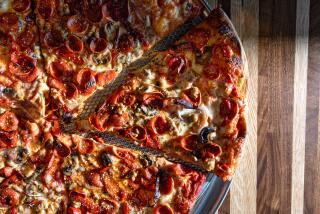The Great Debate: Thick Versus Thin
- Share via
I’ve never understood how anybody could actually like a thin-crust pizza. What is the thrill in covering a limp saltine cracker with pizza toppings and rolling it into little tubes? They’ve got to be kidding.
The first pizzas I ever had were the thin-crust models available in L.A. in the ‘50s, and on the basis of that I went around for years telling everybody I didn’t like Italian food. I used to quote the humor writer Roger Price to the effect that a pizza was evidently a dish of blotter paper smeared with tomato sauce.
Of course, I really didn’t know anything about Italian food, as I discovered when I spent an unplanned day in Rome. Since pizza was about the only Italian dish I knew, I asked for it, and to my amazement there turned out to be all sorts of regional pizzas, many of them with thick, luxurious crusts. One, which might have been described to me as the native Roman style, had two thick crusts, with a layer of fried onions sandwiched between them.
It was a revelation: the immortal aroma of fresh bread, complemented with flavorings cooked right onto it. I think one reason why an estimated 56.5% of the American public prefers thick-crust pizza is that a pizzeria is usually the only place where you can be sure of getting bread smoking-fresh from the oven--often that best and most ancient of bread ovens, the kind made of brick.
Of course, Americans did invent the “deep-dish” pizza, where the bread is nothing and the topping is all. I understand; it’s what we did to the European tart, turning it into a fruit pudding in a crust, and to cake, which we made a pedestal for carrying frosting.
I understand; this is the land of bounty and so on. We want the goodies. But why throw out the baby with the bath water? The toppings are nice for variety, but pizza is basically a bread. Anybody who doesn’t feel this way might want to look into this new invention called the tortilla.
More to Read
Eat your way across L.A.
Get our weekly Tasting Notes newsletter for reviews, news and more.
You may occasionally receive promotional content from the Los Angeles Times.










